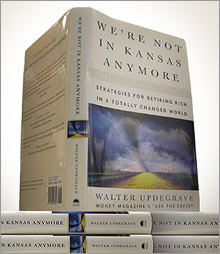|
Column Archive
Money Magazine Ask the Expert by Walter Updegrave
Debunking a millionaire myth
In the real world, stocks simply don't return 20 percent a year over decades.
Sign up for the Ask the Expert e-mail newsletter NEW YORK (MONEY Magazine) - I heard on a radio program that if you invest $1,000 in stocks or stock funds and earn 20 percent a year, you will be a millionaire after 36 years. Is this true, and, if so, how would I get started on such a plan? -- Dwight Butler, Ellicott City, Maryland
I don't know what radio show you were listening to. But if what you've told me is any indication of the kind of advice the show gives about investing and personal finance, I'd say the people who run it are either woefully ill-informed or investment hucksters or both. And I would recommend that you don't invest a penny on the basis of what the program has to say. Yes, it's true that you would end up with a bundle if you invested $1,000 today and earned 20% a year on it for the next 36 years. You wouldn't quite get to a million bucks, but by my calculations, you would have a bit less than $709,000, still a tidy sum. But the scenario you describe has no link to financial reality. And for anyone to suggest that it represents some attainable way of becoming a millionaire or even accumulating a large amount of wealth is total nonsense. Why? Well, in the real world stocks simply don't return 20 percent a year over the course of three to four decades. There may be times, such as the go-go '90s, when investors are lucky enough to see that level of returns for a short period, say, five to 10 years. But those bursts of super-high returns are aberrations. Over the course of many decades, history shows that stocks return about 10 percent or so on average, and even that's not a given. In fact, because stock prices today are still relatively high versus their earnings compared with the past, many experts believe that over the next 20 years or so stock returns will come in below that 10 percent historical average. So perhaps 8 percent to 9 percent might be more realistic, although there are some market watchers who feel even that is a bit optimistic. Over-shooting can be costly
I don't claim to have any special insight into future stock returns (although an annualized return of annualized 8 percent or so for the next two decades seems like a reasonable expectation). But I do know this. We're not going to get any 20 percent a year and that anyone who plans on anything close to that number is going to be disappointed, or worse. By worse, I mean that anyone who actually shoots for 20 percent will probably end up in such speculative investments that the downsize won't be earning, say, 15 percent instead of 20 percent. The risk will be outright losses, because any investment that has an outside shot of returning 20 percent a year for decades also has a high probability of just flaming out entirely. Fortunately, there's a much more reliable way you can build wealth over the long term that doesn't hinge on achieving unrealistic returns -- that is, invest modest amounts regularly in a diversified portfolio. For example, if you invest $100 a month in a portfolio that earns, say, 8 percent a year, you would have a bit over $234,000 after 36 years. Increase that monthly investment to $200, and you would have twice that amount, or about $468,000. And if you invest $400 a month, you would be pretty darn close to hitting that million-dollar mark. Now, I don't want to be like that radio station and suggest that even these more modest results are guaranteed. They're not. Stocks could very well fall short of delivering annualized gains of 8 percent. And even if they manage that feat, they certainly won't return 8 percent every single year like clockwork. Some years they'll return more, others less, and there will be losses thrown in as well. So the amount you would actually end up with would be different than the amounts above, which are based on a steady 8 percent return. But the point here isn't for me to predict exactly how much money you'll end up with. Neither I, nor anyone else, can do that. Rather, it's to suggest to you that you're much better off investing on a regular basis and shooting for a reasonable return rather than making a small one-time investment and counting on a rate of return you'll never get. In short, it's the difference between planning on the basis of reasonable expectations that are likely to get you close to your goal even if they don't pan out exactly vs. planning on the basis of a fantasy scenario that has zip likelihood of coming true. For specific advice on how to create the sort of reasonable plan I'm talking about, I suggest you check out Do it now: 10 simple strategies for finally achieving your financial goals. You'll find useful tips on how to save more, get out of debt, cut your taxes and create a successful long-term investing strategy. So turn off that radio and start creating a saving and investing plan based on sound financial principles, not hype. I can't guarantee you'll become a millionaire, but I can say you'll have a better shot at becoming financially secure. Also see: How even Average Joes can retire rich ---------------------- Walter Updegrave is a senior editor at MONEY Magazine and is the author of "We're Not in Kansas Anymore: Strategies for Retiring Rich in a Totally Changed World."
For all the latest headlines in Ask the Expert, click here. |
|


